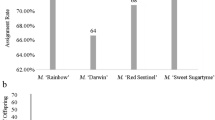Abstract
Mating systems are generally thought to be important factors in determining the amount and nature of genetic variability in a population. Nearly 1,000 individuals at a single location (Lucknow) and over two years were crossed and subsequently scored for selfing versus outcrossing in 9–10 monohybrid populations of opium poppy (Papaver somniferum). Three different alleles of two marker loci (two—R/r and P/p—for anthocyanin locus and B/b for capsule size locus) were used to determine the male gametes that had effected fertilizations in F2 recessives (rr, pp and bb). The estimates of the gene frequency-based outcrossing parameter (α) were found to vary with year, cross and marker locus used (α range: 7.21–71.03%). Study of the two dihybrid crosses concerning the two marker loci simultaneously, further confirmed that outcrossing at the R/r or P/p locus was significantly greater than that at the B/b locus. The nature of the outcrossing was, in general, nonrandom. In this species, in general, selfing predominated, with one exception in respect of monohybrid crosses involving the purple form of anthocyanin locus, in which outcrossing predominated.

Similar content being viewed by others
References
Allard RW, Workman PL (1963) Population studies in predominantly self-pollinated species. IV. Seasonal fluctuations in estimated values of genetic parameters in lima bean populations. Evolution 18:470–480
Allard RW, Jain SK, Workman PL (1968) The genetics of inbreeding species. Adv Genet 14:55–131
Basak SL, Chaudhuri BB (1966) Extent and nature of natural cross-pollination in “Tossa” Jute (Corchorus olitorius L.). Indian J Agric Sci 36:267–272
Basak SL, Gupta S (1972) Quantitative studies on the mating system of Jute (Corchorus olitorius L.). Theor Appl Genet 42:319–324
Basak SL, Paria P (1975) Quantitative studies on the mating system of Jute (Corchorus capsularis L.). Theor Appl Genet 46:347–351
Baye T, Becker HC (2004) Natural outcrossing rate in Vernonia galamensis. Plant Breed 123:398–399
Chauhan SP (1989) Studies on induced mutagenesis in opium poppy (Papaver somniferum L.) in relation to genetic improvement and cytogenetic analysis. PhD thesis, Kanpur University, India
Chowdhury MA, Slinkard AE (1997) Natural outcrossing in grasspea. J Hered 88:154–156
Dana S (1969) Non-random out-crossing in mung bean. Indian J Genet Plant Breed 29:142–146
Fyfe JL, Bailey NTJ (1951) Plant breeding studies in leguminous forage crop. I. Natural crossing in winter beans. J Agric Sci 41:371–378
Gutierrez MG, Sprague GF (1959) Randomness of mating in isolated polycross planting of maize. Genetics 44:1075–1082
Harding J, Tucker CL (1964) Quantitative studies on mating systems I. Evidence for the non-randomness of out-crossing in Phaseolus lunatus. Heredity 19:369–381
Jain SK (1961) A note on estimation of natural crossing by maximum likelihood method. Indian J Genet 21:146–148
Kadereit JW (1986a) Papaver somniferum L. (Papaveraceae): a triploid hybrid? Bot Jahrb Syst 106:221–244
Kadereit JW (1986b) A reuision of Papaver L. Sect. Papaver (Papaveraceae). Bot Jahrb Syst 108:1–16
Kandpal A (2005) Cytogenetical investigations in induced mutants and inter-specific hybrids of Papaver species. PhD thesis, Lucknow University, India
Khanna KR, Shukla S (1983) Degree of out-crossing in opium poppy. New Botanist 10:65–67
Kumar B (2007) Study on genetic architecture of opium poppy (Papaver somniferum L.) in relevance to yield improvement. PhD thesis, Lucknow University, India
Nei M, Syaktdo K (1958) The estimation of out-crossing in natural population. Jpn J Genet 33:46–51
Nyman V, Hall O (1976) Some varieties of P. somniferum L. with changed morphine alkaloid. Hereditas 84:69–76
Parzies HK, Fosung Nke C, Abdel-Ghani AH, Geiger HH (2008) Outcrossing rate of barley genotypes with different floral characteristics in drought-stressed environments in Jordan. Plant Breed 127:536–538
Patra NK, Chauhan SP (1990) Morpho-physiology and genetics of induced mutants expressed in the M1 generation in opium poppies. J Hered 81:347–350
Patra NK, Ram RS, Chauhan SP, Singh AK (1992) Quantitative studies on the mating system of opium poppy (Papaver somniferum L.). Theor Appl Genet 84:299–302
Satpute GK (2000) Mutation breeding for genetic enhancement of desirable alkaloids in opium poppy (Papaver somniferum L.). PhD thesis, Lucknow University, India
Sharma JR, Singh OP (1983) Genetics and genetic improvement. In: Husain A, Sharma JR (eds) The opium poppy. Central Institute of Medicinal and Aromatic Plants, Lucknow, India, pp 39–68
Srivastava HK, Singh D (2006) Honeybees foraging response in genetically diversified opium poppy. Bioresour Technol 97:1578–1581
Vaidya KR (2000) Natural cross-pollination in roselle, Hibiscus sabdariffa L. (Malvaceae). Genet Mol Biol 23:667–669
Workman PL (1964) The maintenance of heterozygosity by partial negative assortative mating. Genetics 50:1369–1382
Acknowledgments
The authors are thankful to Dr. S.P.S. Khanuja, Director, CIMAP, Lucknow, for providing the necessary facilities during the investigation. They are also very grateful to Prof. (Dr.) S. L. Basak, Ex-Director of C.R.I.J.A.F. (ICAR), West Bengal, for giving valuable suggestions on up-grading the paper, and to P. Christou and anonymous reviewers for valuable comments and improving the manuscript.
Author information
Authors and Affiliations
Corresponding author
Rights and permissions
About this article
Cite this article
Kumar, B., Patra, N.K. Gene frequency-based estimation of natural outcrossing in opium poppy (Papaver somniferum L.). Mol Breeding 26, 619–626 (2010). https://doi.org/10.1007/s11032-010-9395-3
Received:
Accepted:
Published:
Issue Date:
DOI: https://doi.org/10.1007/s11032-010-9395-3




